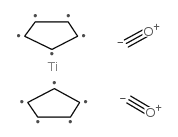12129-51-0
| 中文名 | 二羰基双(环戊二烯基)钛 |
|---|---|
| 英文名 | bis(oxomethylidene)titanium,cyclopenta-1,3-diene |
| 中文别名 | 羰基双(环茂二烯基)钛 |
| 英文别名 | MFCD00143762 |
| 沸点 | 60ºC/0.001mm |
|---|---|
| 熔点 | 90ºC |
| 分子式 | C12H10O2Ti |
| 分子量 | 234.07400 |
| 闪点 | 60°C/0.001mm subl. |
| 精确质量 | 234.01600 |
| LogP | 1.62700 |
| 外观性状 | crystal | red |
| 储存条件 | 常温密闭避光,通风干燥处 |
| 稳定性 | 1.常温常压下稳定 避免的物料 氧化物 水分/潮湿 热 2.可自燃,必须在惰性气氛下保存和操作使用。 |
| 水溶解性 | Insoluble in water. |
| 分子结构 | 1、摩尔折射率:无可用的 2、摩尔体积(cm3/mol):无可用的 3、等张比容(90.2K):无可用的 4、表面张力(dyne/cm):无可用的 5、介电常数:无可用的 6、极化率(10-24cm3):无可用的 7、单一同位素质量:234.016027 Da 8、标称质量:234 Da 9、平均质量:234.0736 Da |
| 计算化学 | 1.疏水参数计算参考值(XlogP):无 2.氢键供体数量:0 3.氢键受体数量:4 4.可旋转化学键数量:0 5.互变异构体数量:无 6.拓扑分子极性表面积34.1 7.重原子数量:15 8.表面电荷:-2 9.复杂度:333 10.同位素原子数量:0 11.确定原子立构中心数量:0 12.不确定原子立构中心数量:0 13.确定化学键立构中心数量:0 14.不确定化学键立构中心数量:0 15.共价键单元数量:3 |
| 更多 | 1. 性状:未确定 2. 密度(g/mL,25℃):未确定 3. 相对蒸汽密度(g/mL,空气=1):未确定 4. 熔点(ºC):90 5. 沸点(ºC,常压):未确定 6. 沸点(ºC,0.001mmHg):60 7. 折射率:未确定 8. 闪点(ºC):未确定 9. 比旋光度(º):未确定 10. 自燃点或引燃温度(ºC):未确定 11. 蒸气压(20ºC):未确定 12. 饱和蒸气压(kPa,60ºC):未确定 13. 燃烧热(KJ/mol):未确定 14. 临界温度(ºC):未确定 15. 临界压力(KPa):未确定 16. 油水(辛醇/水)分配系数的对数值:未确定 17. 爆炸上限(%,V/V):未确定 18. 爆炸下限(%,V/V):未确定 19. 溶解性:溶于大多数有机溶剂,但会与氯仿和二氯甲烷反应。 |
|
Section 1: Product Identification Chemical Name:Bis(cyclopentadienyl)dicarbonyl titanium(II), min. 98% CAS Registry Number:12129-51-0 Formula:(C5H5)2Ti(CO)2 EINECS Number:none Chemical Family:metallocene Titanium, bis[(1,2,3,4,5-.eta.)-2,4-cyclopentadiene-1-yl]dicarbonyl, Dicarbonylbiscyclopentadienyl titanium,
Synonym: Titanocene dicarbonyl Section 2: Composition and Information on Ingredients IngredientCAS NumberPercentACGIH (TWA)OSHA (PEL) Title Compound12129-51-0100%no datano data Section 3: Hazards Identification Emergency Overview:No particular hazard associated with this material. Primary Routes of Exposure:Ingestion Eye Contact:May cause slight to mild irritation of the eyes. Skin Contact:May cause slight to mild irritation of the skin. Inhalation:May be irritating to the nose, mucous membranes and respiratory tract. Ingestion:No information on the physiological effects of ingestion. Acute Health Affects:May be irritating to skin, eyes and respiratory tract. Chronic Health Affects:No information available on long-term chronic effects. NTP:No IARC:No OSHA:No SECTION 4: First Aid Measures Immediately flush the eyes with copious amounts of water for at least 10-15 minutes. A victim may need Eye Exposure: assistance in keeping their eye lids open. Get immediate medical attention. Wash the affected area with water. Remove contaminated clothes if necessary. Seek medical assistance if Skin Exposure: irritation persists. Remove the victim to fresh air. Closely monitor the victim for signs of respiratory problems, such as difficulty in Inhalation: breathing, coughing, wheezing or pain. In such cases seek immediate medical assistance. Seek medical attention immediately. Keep the victim calm. Give the victim water (only if conscious). Induce Ingestion: vomiting only if directed by medical personnel. SECTION 5: Fire Fighting Measures Flash Point:no data Autoignition Temperature:no data Explosion Limits:no data Extinguishing Medium:carbon dioxide or dry powder If this product is involved in a fire, firefighters should be equipped with NIOSH approved positive pressure Special Fire Fighting Procedures: self-contained breathing apparatus. Hazardous Combustion andIf involved in a fire this product may emit toxic and corrosive fumes. Decomposion Products: Unusual Fire or Explosion Hazards: Flammable solid SECTION 6: Accidental Release Measures Spill and Leak Procedures:Remove sources of ignition. do not raise dust. sweep up the solids and dispose of properly. SECTION 7: Handling and Storage Handle and store the material under an inert atmosphere of nitrogen or argon. Keep away from heat and Handling and Storage: moisture. SECTION 8: Exposure Controls and Personal Protection Eye Protection:Always wear approved safety glasses when handling a chemical substance in the laboratory. Skin Protection:Wear protective clothing and gloves. Ventilation:If possible, handle the material in an efficient fume hood. If ventilation is not available a respirator should be worn. The use of respirators requires a Respiratory Respirator: Protection Program to be in compliance with 29 CFR 1910.134. Ventilation:If possible, handle the material in an efficient fume hood. Additional Protection:No additional protection required. SECTION 9: Physical and Chemical Properties Color and Form:red xtl Molecular Weight:234.09 Melting Point:no data Boiling Point:no data Vapor Pressure:no data Specific Gravity:no data Odor:not determined Solubility in Water:insoluble SECTION 10: Stability and Reactivity Stability:air sensitive Hazardous Polymerization:No hazardous polymerization. Conditions to Avoid:none Incompatibility:oxidizing agent Decomposition Products:carbon monoxide, carbon dioxide, titanium oxide and organic fumes. SECTION 11: Toxicological Information RTECS Data:No information available in the RTECS files. Carcinogenic Effects:no data Mutagenic Effects:no data Tetratogenic Effects:no data SECTION 12: Ecological Information Ecological Information:No information available SECTION 13: Disposal Considerations Disposal:Dispose of according to local, state and federal regulations. SECTION 14: Transportation Shipping Name (CFR):Flammable solids, Organic, N.O.S. Hazard Class (CFR):4.1 Additional Hazard Class (CFR):NA Packaging Group (CFR):II UN ID Number (CFR):UN# 1325 Shipping Name (IATA):Flammable solid, Organic, N.O.S. Hazard Class (IATA):4.1 Additional Hazard Class (IATA):NA Packaging Group (IATA):II UN ID Number (IATA):UN# 1325 SECTION 15: Regulatory Information TSCA:Not listed in the TSCA inventory. SARA (Title 313):Title compound not listed Second Ingredient:none SECTION 16 - ADDITIONAL INFORMATION N/A |
|
生态学数据: 通常对水体是稍微有害的,不要将未稀释或大量产品接触地下水,水道或污水系统,未经政府许可勿将材料排入周围环境。
|
| 危害码 (欧洲) | T+ |
|---|---|
| 风险声明 (欧洲) | 20/21/22-36/37/38-40 |
| 安全声明 (欧洲) | 26-36/37/39 |
| 危险品运输编码 | UN3466 |
| 包装等级 | II |
| 危险类别 | 6.1 |





